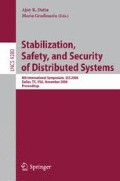Abstract
In this paper, we quantify the amount of “practical” information (i.e. views obtained from the neighbors, colors attributed to the nodes and links) to obtain “theoretical” information (i.e. the local topology of the network up to distance k) in anonymous networks. In more details, we show that a coloring at distance 2k + 1 is necessary and sufficient to obtain the local topology at distance k that includes outgoing links. This bound drops to 2k when outgoing links are not needed. A second contribution of this paper deals with color bootstrapping (from which local topology can be obtained using the aforementioned mechanisms). On the negative side, we show that (i) with a distributed daemon, it is impossible to achieve deterministic color bootstrap, even if the whole network topology can be instantaneously obtained, and (ii) with a central daemon, it is impossible to achieve distance m when instantaneous topology knowledge is limited to m − 1. On the positive side, we show that (i) under the k-central daemon, deterministic self-stabilizing bootstrap of colors up to distance k is possible provided that k-local topology can be instantaneously obtained, and (ii) under the distributed daemon, probabilistic self-stabilizing bootstrap is possible for any range.
Access this chapter
Tax calculation will be finalised at checkout
Purchases are for personal use only
Preview
Unable to display preview. Download preview PDF.
References
Beauquier, J., Gradinariu, M., Johnen, C.: Memory space requirements for self-stabilizing leader election protocols. In: PODC, pp. 199–207 (1999)
Boldi, P., Vigna, S.: Universal dynamic synchronous self-stabilization. Distributed Computing 15(3), 137–153 (2002)
Delaët, S., Tixeuil, S.: Tolerating transient and intermittent failures. Journal of Parallel and Distributed Computing 62(5), 961–981 (2002)
Dolev, S.: Self-stabilization. MIT Press, Cambridge (2000)
Dolev, S., Herman, T.: Superstabilizing protocols for dynamic distributed systems. Chicago J. Theor. Comput. Sci. (1997)
Gouda, M.G., Herman, T.: Adaptive programming. IEEE Trans. Software Eng. 17(9), 911–921 (1991)
Gradinariu, M., Tixeuil, S.: Self-stabilizing vertex coloring of arbitrary graphs. In: International Conference on Principles of Distributed Systems (OPODIS 2000), Paris, France, December 2000, pp. 55–70 (2000)
Herman, T., Tixeuil, S.: A distributed tdma slot assignment algorithm for wireless sensor networks. In: Nikoletseas, S.E., Rolim, J.D.P. (eds.) ALGOSENSORS 2004. LNCS, vol. 3121, pp. 45–58. Springer, Heidelberg (2004)
Hill, J.L., Culler, D.E.: Mica: A wireless platform for deeply embedded networks. IEEE Micro 22(6), 12–24 (2002)
Masuzawa, T.: A fault-tolerant and self-stabilizing protocol for the topology problem. In: Proceedings of the Second Workshop on Self-Stabilizing Systems, pp. 1.1–1.15 (1995)
Masuzawa, T., Tixeuil, S.: A self-stabilizing link coloring algorithm resilient to unbounded byzantine faults in arbitrary networks. In: Anderson, J.H., Prencipe, G., Wattenhofer, R. (eds.) OPODIS 2005. LNCS, vol. 3974, pp. 118–129. Springer, Heidelberg (2006)
Peleg, D.: Distributed Computing: A Locality-Sensitive Approach. SIAM, Philadelphia (2000)
Sakamoto, N.: Structure of initial conditions for distributed algorithms. IEICE Transactions on Information and Systems E83-D(12), 2029–2038 (2000)
Spinelli, J.M., Gallager, R.G.: Event driven topology broadcast without sequence numbers. IEEE Transactions on Communications 37, 468–474 (1989)
Yamashita, M., Kameda, T.: Leader election problem on networks in which processor identity numbers are not distinct. IEEE Trans. Parallel Distrib. Syst. 10(9), 878–887 (1999)
Author information
Authors and Affiliations
Editor information
Editors and Affiliations
Rights and permissions
Copyright information
© 2006 Springer-Verlag Berlin Heidelberg
About this paper
Cite this paper
Masuzawa, T., Tixeuil, S. (2006). On Bootstrapping Topology Knowledge in Anonymous Networks. In: Datta, A.K., Gradinariu, M. (eds) Stabilization, Safety, and Security of Distributed Systems. SSS 2006. Lecture Notes in Computer Science, vol 4280. Springer, Berlin, Heidelberg. https://doi.org/10.1007/978-3-540-49823-0_32
Download citation
DOI: https://doi.org/10.1007/978-3-540-49823-0_32
Publisher Name: Springer, Berlin, Heidelberg
Print ISBN: 978-3-540-49018-0
Online ISBN: 978-3-540-49823-0
eBook Packages: Computer ScienceComputer Science (R0)

